Samsung Galaxy Tab 10.1 Review: The Sleekest Honeycomb Tablet
by Anand Lal Shimpi on June 13, 2011 5:07 AM EST- Posted in
- Tablets
- Samsung
- Tegra 2
- Galaxy tab 10.1
- Android 3.1
- Mobile
- NVIDIA
The Software
At CTIA Samsung mildly shocked the world by proclaiming that it would be bringing TouchWiz to its first Honeycomb tablet. Google had previously indicated that Honeycomb's UI would be unified and that hardware vendors wouldn't be skinning it, however it later backed off and said that Honeycomb was simply going to be good enough that no one would want to change it.
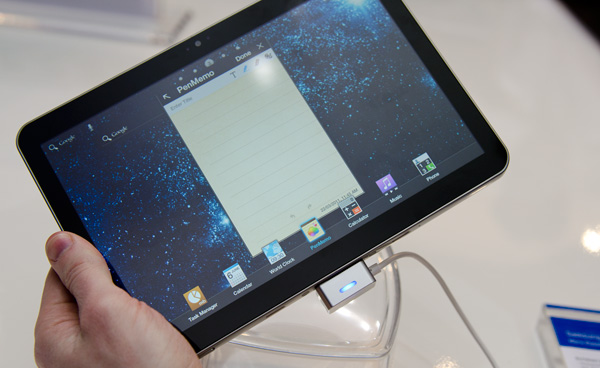
TouchWiz was originally slated to be a part of the Galaxy Tab 10.1 launch
The shipping version of the Galaxy Tab 10.1 (as well as the Limited Edition given out at Google IO) has all hints of the Honeycomb TouchWiz UI removed. There aren't even any Samsung specific widgets that come preloaded on the Galaxy Tab. I'm not sure if Google got tough with Samsung or if Samsung gave up on the idea of skinning Honeycomb after the 3.1 enhancements, but for better or for worse TouchWiz is gone.
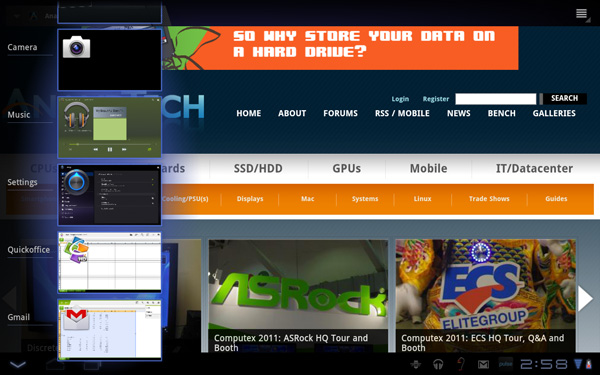
A scrollable recent apps list, a new feature of Android 3.1
One of the big features of TouchWiz on Honeycomb was supposed to be the ability to resize widgets, a feature that Google actually added in with the 3.1 update last month. The Galaxy Tab 10.1 ships with 3.1 from the factory bringing the total number of 3.1 devices up to three in the market today (ASUS' Eee Pad, Motorola Xoom and Samsung Galaxy Tab 10.1). Both the performance and feature enhancements that came along with the 3.1 update apply to the Galaxy Tab 10.1 so I won't go through them again here. If you weren't sold on Honeycomb before the update, the 3.1 bundle isn't going to be enough to make you a convert - but if you were interested in the OS beforehand, the point release makes the experience noticeably better.
Samsung opted for a more conservative default wallpaper on the 10.1 than ASUS did with the Eee Pad. It's impressive how much of an impact an animated wallpaper can have on performance. Samsung's simple switch makes the Galaxy Tab feel snappier by default. We're still a generation or two away from being able to have enough spare CPU cycles and memory bandwidth to throw away at things like frivolous UI elements.
There are still some odd hiccups that bother me about Honeycomb. For example, frame rate when bringing up the apps grid is still lower in portrait mode than in landscape. I also encounter far too many crashes on a regular basis. I still believe Honeycomb is fit for sale but it's definitely not a fully polished product.
While overall UI performance is much improved with 3.1 vs 3.0.1, it's still not perfectly smooth. For doing the handful of things that tablets work very well at Honeycomb definitely gets the job done, but ask too much of it and the experience quickly breaks down into something a lot slower.
Web browsing is still mostly pleasant. While Flash support is there, Honeycomb on a Tegra 2 is still far too sluggish to deliver even a netbook like experience. The problem ultimately boils down to screen resolution and memory bandwidth. At 1280 x 800 there are simply too many pixels to run most moderately complex Flash video while maintaining any semblance of a smooth UI.
Apps
With TouchWiz gone, there's still Samsung's own set of preloaded apps that come with the Galaxy Tab 10.1.
The Music Hub is Samsung's music store powered by 7digital. Tracks sell for between $0.99 and $1.49.
This next one is a bit odd. If you've purchased any Samsung device in the past (e.g. Samsung TV) you'll know the company is particularly fond of outfitting its hardware with its own custom app store. The Galaxy Tab 10.1 is not exempt from this treatment. The tablet comes with an app called Samsung Apps, which is a separate app store that presently has a whopping 6 titles, three of which are Angry Birds variants (Regular, Rio and Seasons). Thankfully all of the titles available in Samsung Apps, at least today, are all available free of charge.
Although the titles are free they are ad supported. Note that the apps themselves aren't delivered through Market so you'll need to enable the installation of non-market apps in order to actually use any of them.
Quickoffice is a basic word processing, spreadsheet and presentation package for Android with some basic MS Office compatibility. ASUS opted for Polaris on the Eee Pad but Quickoffice seems to work just as well.
The suite has some nice features such as one-touch text-to-speech when reading a Word document. We're not quite at the point where a Honeycomb tablet could replace a netbook but we're getting there.
Other than formatting issues, the biggest problem I had with Quickoffice was simply performance. Try to do too much (or forget about an app running in the background) and you're left with an app that just sits there waiting for a slice of CPU time that it seems to only get after decades (in CPU time) of waiting.
Samsung also includes Pulse newsreader (a magazine style RSS reader for tablets):
There's Android Movie Studio for basic video editing, primarily for video shot with the 10.1's cameras:
The performance complaints I mentioned above apply here to AMS as well. I had this app crash a good three times in succession while trying to edit together a simple video of footage I shot with the Galaxy Tab.
Of course there are the usual Android apps that we've covered as a part of Honeycomb (Gmail, Gtalk, Maps, Browser, etc...).
The Google supplied Honeycomb virtual keyboard is there however Samsung opts to use its own custom keyboard by default. I didn't have many complaints about Samsung's keyboard however I'm not a fan of the XT9 predictive text system Samsung's keyboard uses. I prefer the looks of the Samsung keyboard but the functionality of the stock Honeycomb offering.


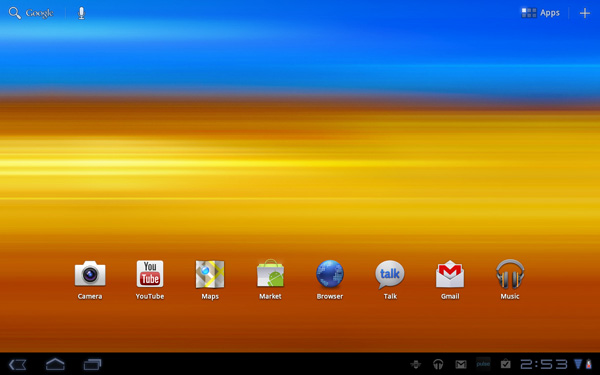
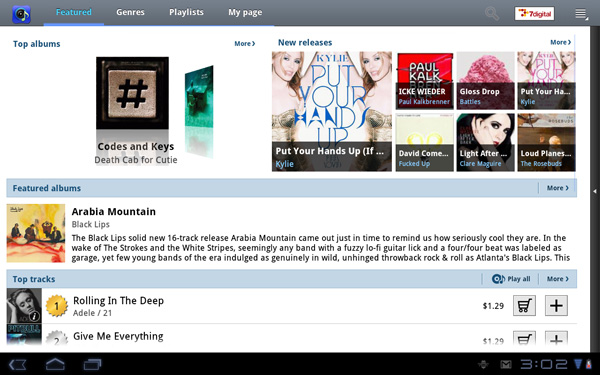
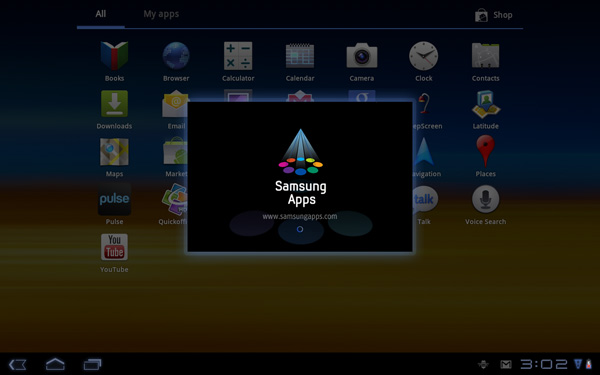
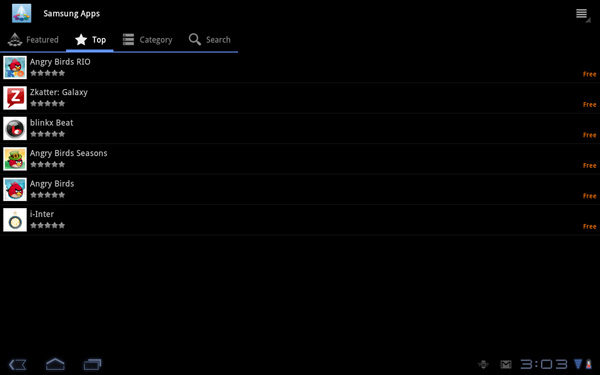
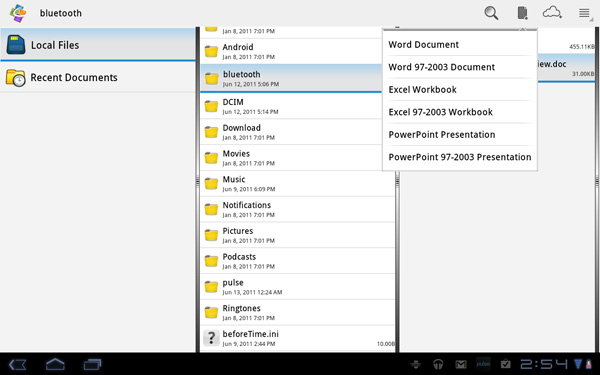
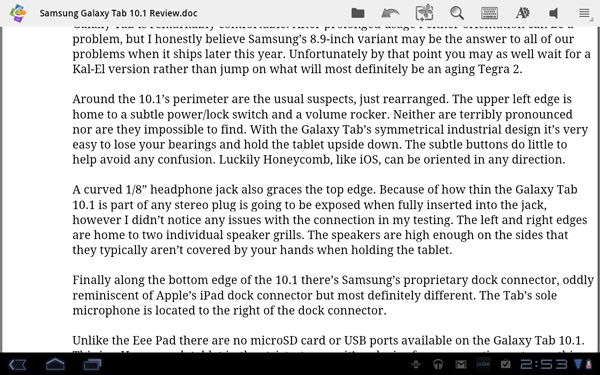
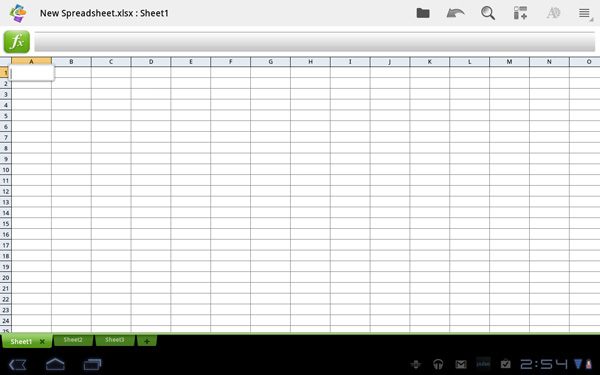
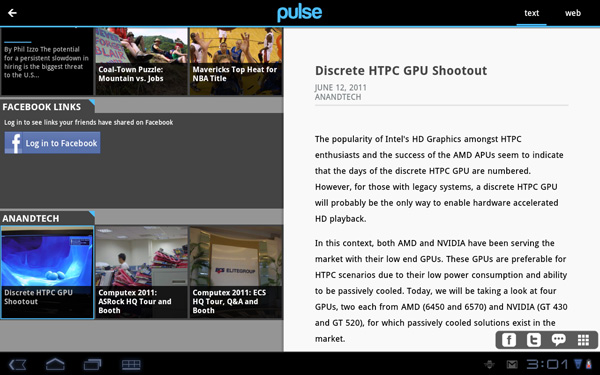

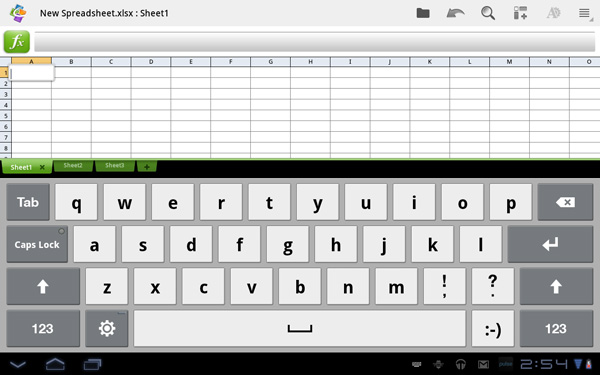








108 Comments
View All Comments
darkhawk1980 - Monday, June 13, 2011 - link
One thing that might be of note to those buying, might be the fact that the secure software key (SSK) for the Asus Transformer has in fact been found. This means that it is now possible to completely unlock the device to do whatever you'd like with it (ie possibly install Ubuntu Linux?). This is something that I'd be surprised if it happened with the Samsung Tab 10.1. While for most people it probably doesn't make a huge difference, but in another month the ability to have both Honeycomb and Ubuntu on the device could be a very compelling argument.Personally, given how much Samsung locks down their devices, I would never buy into their tablets. I still believe the Asus provides a much better overall experience. While it isn't the lightest, nor is it the most thin, it provides the best experience and flexibility. And to be perfectly honest, the price is pretty damn good as well. Having a rooted Asus and being able to overclock it a bit (1.6 GHz and really stable) makes a pretty decent difference in performance.
BTW, I've always wondered, how much of a difference does the resolution difference between the IPad 2 and all other Honeycomb tablets make a difference in the graphical benchmarking tools? I would imagine it does make a decent difference, all things given.
My experience with tablets thus far (have spent a few hours looking at the Acer Iconia and Samsung/Xoom at Best Buy, and bought a Transformer) is that I really do enjoy having it. I like being able to pick it up and browse the web while watching TV during commercials or boring parts of a show. I love reading books and comic books on it. And to be perfectly honest, since I got Plants vs. Zombies the other day for free from Amazon, I use it way too much. More than my wife I think.....
adt6247 - Monday, June 13, 2011 - link
Samsung locking down devices? You on crack? All of the Galaxy S devices shipped with unlocked boot loaders. Samsung also just sent a few Galaxy S II phones to the CyanogenMod team that brought CM7 to the various GSM Galaxy S variants. I rooted my Captivate within an hour of purchase, and I got it on launch day. How much less locked down do you want?My biggest complaint with Samsung was TouchWiz, and that simply isn't an issue here.
ph00ny - Monday, June 13, 2011 - link
That's what i was about to say. Only company active leaving the bootloader unlockedmongo lloyd - Monday, June 13, 2011 - link
Reports have said that Samsung will deliver its TouchWiz UI enhancements in a later update.You can see a very recent video of how it looks on the 8.9 here: http://www.youtube.com/watch?v=yj7M1WTiwGo
StormyParis - Monday, June 13, 2011 - link
to see the insta-obsolescence of those things. Each month brings a new tablet that's da schinitz... for a month. And now Tegra 3 will arrive within a couple of months, and the OEMs that kind messed up first time around (Motorola, a lot; Asus, a bit) will have a second shot at leading the field... Any tablet will be upstaged within 6 tot 12 months anyway, which really is a pain because the new ones will be significantly better (and the current ones are barely "good enough", and those things are a lot more expensive than subsidized phones.I started out waiting for any Android tablet. The first ones, especially the Xoom, where pretty awful, so that morphed into waiting for the eeePad... which is OK, but not as good as the Galaxy. Now I'm thinking 10" is too big. It won't fit into my man-purse and is a bit unwieldy... but the 7-8" alternatives are pretty niche and/or lackluster.
So, in the end, I'm thinking I'll get a cheap Chinese knock-off, test out the format (for web surfing, ebooks, comics, and some videos), and wait 12-24 months for the dust to settle. I've found 8 inchers around 100 USD with 1280x800 and 1024x600 screens (Ainol Novo 8, Zenithink E98)
JasonInofuentes - Monday, June 13, 2011 - link
That's not a terrible plan but try not to be too disheartened. This is simply the expected process of performance increasing with technology advancements played forward really fast. Ten years ago when deciding what computer to buy you would have asked yourself a few questions that had to do with features; at the time they would have involved playing the latest games, fast internet access, expandability and sufficient storage. So, a Radeon 9700, an ethernet NIC, a decent case, a 40 GB drive and a Pentium IV and you were all set. A few years ago you would have added HD video playback, WiFI and turned all the other dials up a few notches. And that's basically where we are today. Ten years ago to meet the demands of most users you needed a pretty high end system, anything less and the compromises were pretty high. Today, a decent video card (nothing integrated, yet), a cheap mobo with all the bells and whistles integrated, a cheap 2TB drive, and Intels cheapest Pentium will probably hit all your feature requests and still fit in a case smaller than the box my 9700 came in.In tablet talk, we are, thankfully, a bit beyond the Pentium IV era, but we're not quite at Penryn, and still a few years off from Nehalem. You can play games, you can watch HD video and you can do all the other things you want to do, you just can't do it as smoothly as you might want, and certainly not so smoothly as you could on your netbook. But we're in the post-PC era, so the days will come.
If I were you, still expecting to wait as much as two years before really committing to the cause, I'd hold off on that Chinese grey market special, pick-up a used Nook Color and throw CM7 on it. It's not Honeycomb but it's not bad either. And when you decide the market is ready for you to throw some real money on a tablet it'll be like booting up a Sandy Bridge powered MacBook Pro after years of using a Powerbook G4. Let us know how it goes!
StormyParis - Monday, June 13, 2011 - link
I'd go for the nook color in a blink if I could get it. I'm in France though, and don't know anyone in the US. Even my brother in Canada can't et it, as far as I can tell.jrs77 - Monday, June 13, 2011 - link
First of all, nice review there Anand.The Galaxy Tab 10.1 looks really good actually and with the bigger resolution then the iPad2 it's more to my liking. However, Android still doesn't feel as good as iOS and that's the real downside of the iPad-competition currently. With a pricetag of the iPad2 I'd take the better OS and go with Apple still, as I don't mind about the iTunes-thingy actually for a device that's primarily ment to browse the web or watch movies while travelling from/to work every day.
I'd like to see a tablet with a fully suported USB-port, that let's me use a internet-stick or external storage, with a pricetag of a netbook ($400). That would really be a step forward actually.
tayb - Monday, June 13, 2011 - link
Still sucks. I'm sorry, but it does. It's half baked and crashes more than a Microsoft Windows beta. It's not a finished product and I'm starting to understand how Google seems to make such rapid improvements to their OS. It's because they release the beta as the full version and then fix all of the massive holes and bugs with new OS releases.I still don't see a tablet offering from any company that I would actually be interested in. $499 for this is not a great deal unless you compare it to the iPad. Hey, the iPad is overpriced. I can walk into any electronics store and get a powerful notebook for $499.
ph00ny - Monday, June 13, 2011 - link
Have you tried 3.1 honeycomb tablets over 3.0? It looks like they're progressing very nicely